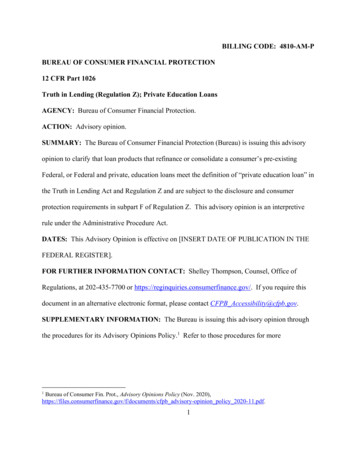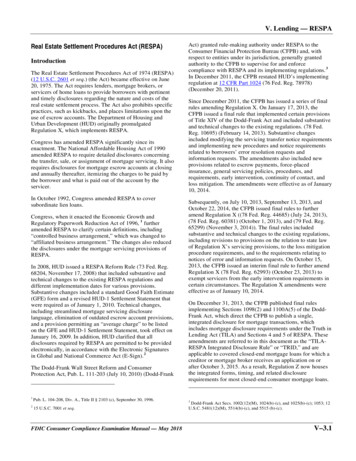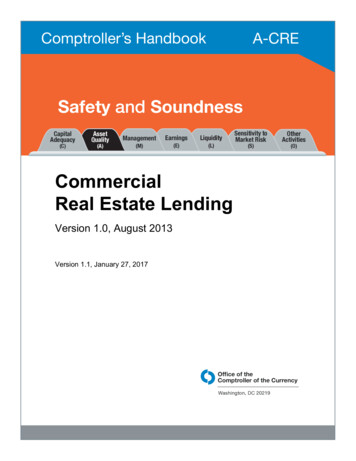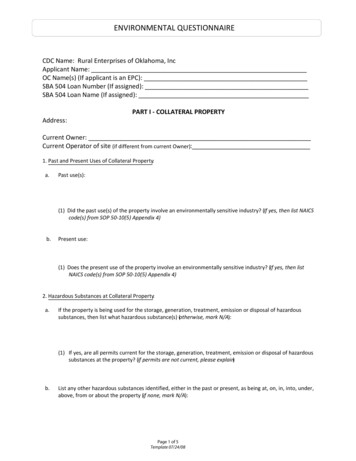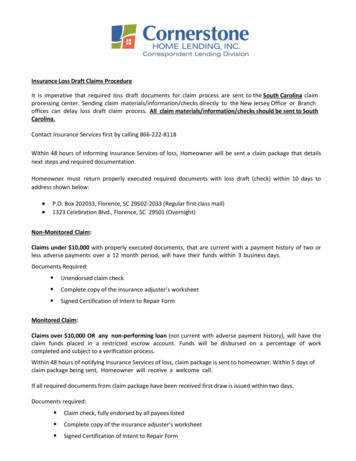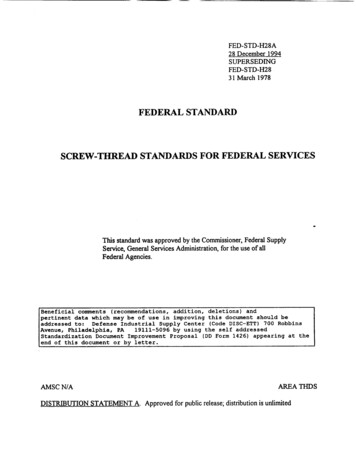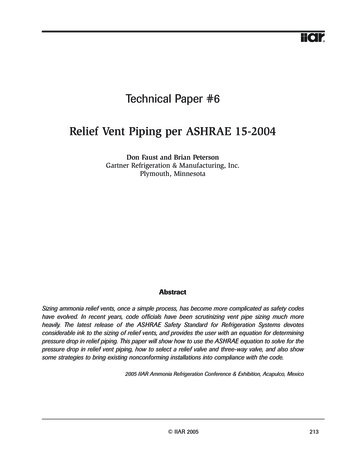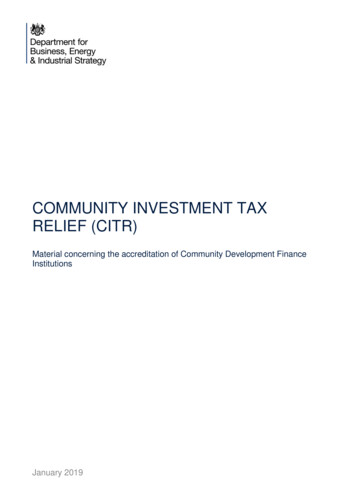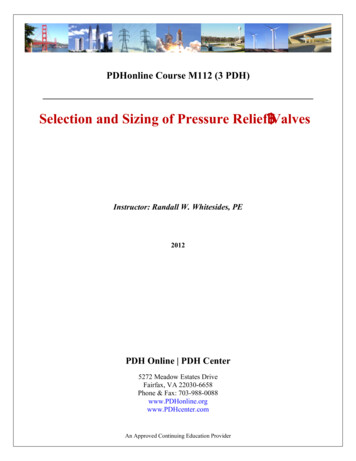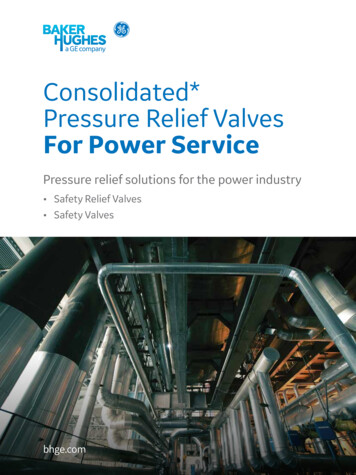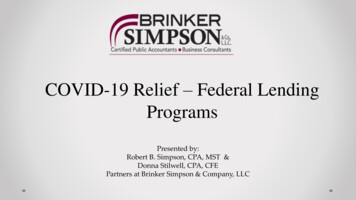
Transcription
COVID-19 Relief – Federal LendingProgramsPresented by:Robert B. Simpson, CPA, MST &Donna Stilwell, CPA, CFEPartners at Brinker Simpson & Company, LLC
DISCLAIMERThis analysis is not tax or legal advice and is not intended or written to be used, andcannot be used, for purposes of avoiding tax penalties that may be imposed on anytaxpayer.The information contained herein is general in nature and based on authorities thatare subject to change. Brinker Simpson & Company, LLC guarantees neither theaccuracy nor completeness of any information and is not responsible for any errors oromissions, or for results obtained by others as a result of reliance upon suchinformation. Brinker Simpson & Company, LLC assumes no obligation to inform thereader of any changes in tax laws or other factors that could affect informationcontained herein. This publication does not, and is not intended to, provide legal, taxor accounting advice, and readers should consult their tax advisors concerning theapplication of tax laws to their particular situations.
Please use the Q&A to ask questions, we may not seequestions asked in the chat sectionWe will email the slides to all participants after thePresentation. Other presentation materials can bedownloaded from the webinar.Information is added and changed almost daily. Pleaserefer to our website at www.brinkersimpsoncares.comfor the most currently available information.
AGENDACOVID RESOURCESUpdate on status of PPP, EIDL and Main Street LendingPPP – OverviewYou’re Funded, now what? Best Practices & Tracking Eligible ExpensesPPP – Forgiveness (final guidance expected 5/15)Main Street Lending Program – Overview and informationEmployee Retention Credit – PPP alternative?Q&A
SUMMARY UPDATE EIDL applications are only being accepted for agricultural businesses but the SBA isstill processing initial / 1st round applications PPP - 90 to 120 billion remaining Final guidance on forgiveness still not released; expected 5/15 – many unansweredquestions PPP safe harbor date to return loan is May 14th ; appears to be required toparticipate in Employee Retention Credit Borrowers MAY participate in both the Main Street Lending Program & the PPP We will finalize and provide a forgiveness workbook to assist with preparingforgiveness applications for lenders.
Source: US Chamber of Commerce
WHY CONSIDER EE RETENTIONCREDIT? EMPLOYEE RETENTION CREDITUp to 5,000 per employee (50% ofqualifying wages up to 10,000)Refundable Tax CreditLess uncertainty – IRS issuedcomprehensive FAQ (telework leavessome unanswered questionsSelf-employed individuals are noteligibleBusinesses deemed essential are noteligiblePAYCHECK PROTECTION PROGRAM Main advantage of PPP wasforgiveness Uncertainty regarding rules May result in unwanted loan that wasused to pay people to stay home priorto reopen Will not support operations throughreopen at limited capacity Guidelines have reduced flexibility indecision making
Overview - Paycheck Protection Program Loan amount 2.5 X average monthly payroll costs Salaries, wages, employer portion of retirement benefits and health insurance (but not for owner’s), net selfemployment income, and others Funds spent over 8 weeks following disbursement Forgiveness available if certain criteria are met within the eligible timeframe: 75% of funds used for payroll costsRestoration of headcountRestoration of compensation levels Portion of a PPP loan that isn’t forgiven must be repaid over two years – after a six-month deferral period – at aninterest rate of 1%.
PPP - You’re Funded, Now What? CAUTION: Follow the spending rules to avoid fines, consider settingup separate account or accounting class to track spending Get your people back on payroll. Forgiveness – What expenses are eligible? counted?latest updates &What needs to change
SEPARATE BANK ACCOUNTSEGREGATING EXPENSE IN GENERAL LEDGERBESTPRACTICESPPP LOANPROCEEDS QUICKBOOKS - CLASSES SEPARATE ACCOUNTS PPP PAYROLL COSTS PPP OTHER COSTS SEPARATE DEPARTMENTPAYROLL COSTS COMPENSATIONSTATE & LOCAL EMPLOYER TAXES (SUTA)HEALTH INSURANCERETIREMENT EXPENSEOTHER COSTS RENT UTILITIES INTERESTSUPPORTING DOCUMENTS
SAMPLE JOURNAL ENTRYExample of Payroll Journal Entry for PPPAccountDebitCreditClass7905: Officer Compensation17,153.847905: Officer Compensation3,846.16SBA - PPP322.16SBA - PPP2,118.76SBA - PPP6530: Wages - Admin783.19SBA - PPP6610: Payroll Taxes - FICA551.136620: Payroll Taxes - SUTA78.896310: Wages - Professional6340: Commissions6630: Payroll Taxes - FUTASBA - PPP1.071015: Checking13,289.981015: Checking9,128.282350: Misc PR Deduction1,000.002210: 401K Payable2,155.416700: 401K Company Match718.4725,573.67PPP Payroll Expenses:Gross Wages up to 15,384.62 per Employee for 8 weeksEmployer SUTA expense401K Company MatchHealth Insurance paid by EmployerSBA - PPP25,573.67Non Payroll Costs:Rent, Utilities, interest on mortgagedebt incurred before2/15/20
FORGIVENESS RULES 1.2.3.PPP Forgiveness Template .xlsx75% of funds must be used for payroll (25% of other expensesare limited to the forgivable portion of the loan)FTE Restoration1.Select base period by choosing the lower FTE count of thefollowing:1.2/15/19 through 6/30/2019 OR 1/1/20 through 2/29/20.2.Your 8 week covered period (see tab 2 on excel template)average headcount must meet or exceed the FTEheadcount from that period. However, you have until 6/30to restore any employees let go / furloughed from 2/15/20through 4/26/20. We advise you to plan to restore by week8 of the covered period.Salary Restoration1.Loan forgiveness is reduced by the amount of reduction inany employee salary in excess of 25% of the total salary orwages of the most recent full quarter that the employeeworked (will be 4Q19 or 1Q20 for most).1.Exclude any employee who received an annualizedrate of 100K for ANY PAY PERIOD in 2019.
MAJOR FORGIVENESS ISSUES1. Define full-time equivalent2. Incurred vs paid3. Salary reduction over 25%; 8 weekperiod to 12/13 week quarter
EXPENSES ELIGIBLE FOR FORGIVENESS Payroll costs; Any payment of interest on any mortgage obligation (not including any prepayment of orpayment of principal on a mortgage obligation) that was incurred before February 15, 2020, Any payment of rent under a leasing agreement in force before February 15, 2020, Any utility payment, including payment for the distribution of electricity, gas, water,transportation, telephone, or internet access for which service began before February 15,2020.
MAJOR FORGIVENESS ISSUES1. Define full-time equivalent2. Incurred vs paid3. Salary reduction over 25%; 8 weekperiod to 12/13 week quarter
Overview Main Street LendingProgram (MSLP) A Federal Reserve bank will lend to a single common special purpose vehicle (SPV); Treasury will useallocated CAREs Act funds to make a 75 billion equity investment in the SPV. The SPV will purchase apercentage of the participation – Lenders would retain 5% - 15% of the loan. 600 billion in funds available. Program runs through 9/30/2020. Eligible lenders include U.S. insured depository institutions, U.S. bank holding companies, and U.S.savings and loan holding companies Main Street loans are not eligible for forgiveness, but offer one year deferments for principal and interestpayments Applications not accepte
Main Street Lending Program (MSLP) – EligibleBorrowers Eligible Borrower must meet the following criteria: May NOT have more than 15,000 employees, OR more than 5 billion in 2019 annualrevenues; Must be created or organized in the United States or under the laws of the United States withsignificant operations in and a majority of its employees based in the United States; AND Must not have received specific support pursuant to the CARES Act (Subtitle A of Title IVfor air carriers, air cargo, and businesses critical to national security) The President, Vice President, an executive department head, Member of Congress or closerelative cannot own over 20% of the outstanding voting stock of the Eligible Borrower.
SOURCE: US CHAMBER OFCOMMERCE
MSLP – TERMS Maturity: 4 years Maximum loan 4X 2019 EBITDA for new facilities; 6X 2019 EBITDA for expanded &priority facility loans with additional limitations based on existing debt Amortization: Principal and interest deferred for 1 year. Interest rate: Adjustable rate of SOFR9 250-400 basis points. Prepayment: Permitted without penalty.
EBITDA DEFINEDThe terms described by the Federal Reserve do not address whether aborrower’s EBITDA will be determined on a basis consistent withexisting credit facilities or whether the borrower would receive thebenefit of non-GAAP add-backs to EBITDA in certifying as to themaximum loan amount requirement for eligible
MSLPRestrictionsUntil 12 months after the loan is no longer outstanding, the borrower may not: participate in stock buybacks pay dividends or other capital distributions must comply with the limitations on compensation in Section 4004 of the CARES act which limitscompensation to officers and employees (details on next slide)Certain government and political officials and their respective families cannot participate in this program
CAREs Act - SEC. 4004. LIMITATION ON CERTAIN EMPLOYEE COMPENSATIONDuring the period beginning on the date on which the agreement is executed and ending on the date that is 1 year after the dateon which the loan or loan guarantee is no longer outstanding—1.No officer or employee of the eligible business whose total compensation exceeded 425,000 in calendar year 2019 1. total compensation which exceeds the total compensation received by the eligible business in calendar year 2019; or2. will receive severance pay or other benefits upon termination of employment which exceeds twice the maximum totalcompensation received by the officer or employee from the eligible business in calendar year 2019; and2. No officer or employee of the eligible business whose total compensation exceeded 3,000,000 in calendar year 2019 mayreceive during any 12 consecutive months of such period total compensation in excess of the sum of—1. 3,000,0002. 50 percent of the excess over 3,000,000 of the total compensation received by the officer or employee from theeligible business in calendar year 2019TOTAL COMPENSATION DEFINED.—In this section, the term “total compensation” includes salary, bonuses, awards of stock, andother financial benefits provided by an eligible business to an officer or employee of the eligible business.
Additional Borrower CRITERIAIf a borrower has outstanding loans with the lender as of December 31, 2019, such loans must have an internal risk rating equivalent to“pass” in the Federal Financial Institutions Examination Council’s supervisory rating system on that date.Additionally, lenders are expected to conduct an assessment of each potential borrower’s financial condition at the time of application.In addition to other certifications required by statutes and regulations, the following certifications are required by eligible borrowers:1.2.3.4.Borrowers must commit to refrain from repaying principal balance or interest on any debt until the Main Street loan is repaid in full,unless the debt or interest payment is mandatory and dueBorrowers must commit that it will not seek to cancel or reduce any of its committed lines of credit with the Main Street lender orany other lenderBorrower must certify that it has a reasonable basis to believe that, as of the date of origination of the Main Street loan, it has theability to meet its financial obligations for at least the next 90 days and does not expect to file for bankruptcy during that time periodBorrowers must commit to following compensation, stock repurchase, and dividend restrictions as outlined in the CARES Act for theduration of the loan term plus 1 year Exception: S-corporations and other tax pass-through entities may continue to makedistributions to the extent reasonably required to cover its owners’ tax obligations in respect of the entity’s earnings
EMPLOYEE RETENTION CREDIT – CARES ACT The CARES Act encourages eligible employers who are financially impacted as a resultof COVID-19 stay at home and isolation orders to retain their employees. Employersare not required to pay employees under the CARES Act Retention Credit, but must doso in order to receive the benefit of the tax credits (“employee retention credits”). The credit available to eligible employers for employee retention is limited to anamount equal to 50 percent of “qualified wages” that the employers pay to theiremployees. Qualified wages are wages paid by an eligible employer to employees afterMarch 12, 2020, and before January 1, 2021. Qualified wages include the eligibleemployer’s qualified health plan expenses that are properly allocable to the wages. Effective period for qualified wages is 3/12/2020 through 1/1/2021.
Am I eligible?Qualifying employers must fall into one of two categories: The employer’s business is fully or partially suspended by government order due toCOVID-19 during the calendar quarter; OR The employer’s gross receipts are below 50% of the comparable quarter in 2019. Oncethe employer’s gross receipts go above 80% of a comparable quarter in 2019, theemployer no longer qualifies after the end of that quarter.These measures are calculated each calendar quarter. You can notparticipate in the Paycheck Protection Program and take advantage ofthe employee retention credit.
EXAMPLE OF EE RETENTION CREDIT.Q1 2019 Receipts2020 Receipts150,000.0073,000.00Less than 50%Q2Q3Q4 180,000.00 150,000.00 150,000.00 117,000.00 109,500.00 127,500.0049%65%73%85% 80% 80%TOTALQualifiying Wages (max of 10,000per EE) 143,200.00 18,250.00EE Retention Credit 71,600.00 9,125.00Q1 2019 Receipts2020 Receipts150,000.0073,000.00Less than 50%TOTAL 29,250.00 14,625.00* all quarters eligible 38,325.00 57,375.00 19,162.50 28,687.50Q2Q3Q4 180,000.00 150,000.00 150,000.00 117,000.00 124,500.00 127,500.0049%65%83%85% 80% 80%Qualifiying Wages (max of 10,000per EE) 202,500.00 37,500.00EE Retention Credit 67,500.00 18,750.00 22,500.00 26,250.00 * Last eligible quarter is the 3rd when the 80% test is met 45,000.00 52,500.00 67,500.00-
What Wages Qualify? If an eligible employer averaged more than 100 full-time employees in 2019, qualifiedwages are the wages paid to an employee during a period the employee is not providingservices due to either (1) a full or partial suspension of operations by order of agovernmental authority due to COVID-19, or (2) a significant decline in gross receipts. If an eligible employer averaged 100 or fewer full-time employees in 2019, qualifiedwages are the wages paid to any employee during any period of economic hardship. As of May 7th, 2020 – health care expenses paid on behalf of furloughed employees maybe treated as qualified wages (subject to the 10,000 maximum per EE)
How Much is Covered? The maximum amount of qualified wages taken into account with respect to each employee, for all calendar quartersis 10,000, so that the maximum amount of the employee retention credit for an eligible employer for qualified wagespaid to each employee is 5,000.Eligible employers may not receive both the employee retention credit and a small business interruption loanunder the paycheck protection program under the CARES Act.Employers are eligible to claim both credits under the FFCRA and CARES Act, but the amount of qualifiedwages for which an employer may claim the credit under the CARES Act does not include the amount ofqualified sick and family leave wages for which the employer received tax credits under the FFCRA.Note: One question requiring clarification from the IRS is whether an employer that moves to tele-working could takethe position that they had experienced a partial shutdown for purposes of determining qualified wages if the employerdid so prior to a government restriction on going to work.
PAYING FOR & CLAIMING THE COVID-19 TAX CREDITS Employers can be immediately reimbursed for the credit by reducing their required deposits ofpayroll taxes that have been withheld from employees’ wages by the amount of the credit. Eligible employers will report their total qualified wages and the related health insurance costsfor each quarter on their quarterly employment tax returns or Form 941 beginning with thesecond quarter. If the employer’s employment tax deposits exceed the credit, the employer mayreceive an advance payment from the IRS by submitting Form 7200. Employers eligible for advance payments of the three credits can find IRS Form 7200 (advancePayment of Employer Credits Due to COVID-19 )
Example: Advance Payments of COVID-19 Tax Credits The instructions to Form 7200 contain the following example showing how an employercould reduce its employment tax deposits and claim an advance payment for the excessof the employer’s credit over the amount of the retained tax deposits: An employer entitled to a 10,000 credit under the CARES Act that is required todeposit 8,000 in employment taxes could retain the entire 8,000 of taxes as a portionof the tax credit it is entitled to and file a request for an advance payment for theremaining 2,000 using Form 7200.
Q&AVisit www.brinkersimpsoncares.com for the most upto date information and / or email questions tocares@brinkersimpson.com .
Brinker Simpson & Company, LLC guarantees neither the accuracy nor completeness of any information and is not responsible for any errors or omissions, or for results obtained by others as a result of reliance upon such . Salaries, wages, employer portion of retirement benefits and
